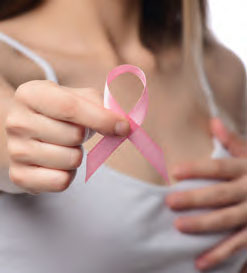Phyllodes tumor (phyllodes tumor, cystosarcoma phyllodes)

Structural asymmetry between a woman’s breasts is normal. However, a significant difference in the breast size or shape may occur in the case of developmental or hormonal disorders or due to idiopathic factors.
Disorders / Developmental variants
Breast developmental disorders include breast absence, an additional breast or breasts, and significant asymmetry in the size or shape of the mammary glands. Amastia – i.e., an absence of breast tissue – is a rare condition most commonly diagnosed in women with Poland syndrome, which also includes the absence of muscles in the chest wall on the same side of the body. Polymastia – also known as accessory breasts – is the condition of having an additional breast or breasts. It is diagnosed in 2–6% of the population. In most cases, extra breasts are located in the upper external quadrants of the breasts, towards the armpits. Polythelia is the name for an additional nipple, which is diagnosed in 1–2% of the population.
Hormonal factors
If the shapes of a woman’s breasts are uniform, a significant asymmetry in size usually results from an asymmetrical response to hormonal stimulation during their growth phase. Premature thelarche (premature breast development) is a mild form of precocious puberty, in which one or two breasts become enlarged. It generally occurs in girls aged 1–2 years old.
Breast size changes during pregnancy and breastfeeding. The breasts, which are stimulated to secrete milk, grow larger. If this enlargement is accompanied by pain and palpable hardening, a milk stasis due to a plugged duct should be taken into consideration. Milk stasis can lead to the appearance of redness or increased skin temperature and may indicate mastitis.
Asymmetry in breast shape changes naturally with age and depends on the amount and location of glandular tissue, as well as skin flexibility.
Acquired asymmetry
An acquired asymmetry of the breast shape and size occurs after breast surgery, benign and malignant tumor resection, burns, infections, injuries, and the formation of scars.
1. Hughes LE, Mansel RE. Breast anatomy and physiology. In Hughes LE, Mansel RE, Webster DJT, editors, Benign Disorders and Diseases of the Breast: Concepts and Clinical Management. 2nd ed. London: Harcourt Publishers; 2000. p. 7–20. p>
2. Maxwell GP. Breast asymmetry. Aesthetic Surg J 2001;21:552–561.
Zostaw swój numer, oddzwonimy i odpowiemy na Twoje pytania
I consent to the use of telecommunication end devices by BRASTER S.A. for commercial purposes and direct marketing, pursuant to Article 172 of the Act of July 16, 2004 – Telecommunications Law and the Act of July 18, 2002 on electronic provision of services. In particular, I consent to receiving incoming phone calls from BRASTER S.A. I declare that I have been informed that the above consent is voluntary and may be revoked at any time.
Strona http://braster.eu/nl realizuje sprzedaż jedynie na terenie Holandii. Jeżeli chcesz zrealizować zamówienie na terenie Polski przejdź na http://braster.eu/pl
I consent to the use of telecommunication end devices by BRASTER S.A. for commercial purposes and direct marketing, pursuant to Article 172 of the Act of July 16, 2004 – Telecommunications Law and the Act of July 18, 2002 on electronic provision of services. In particular, I consent to receiving incoming phone calls from BRASTER S.A. I declare that I have been informed that the above consent is voluntary and may be revoked at any time.
Your message was sent.
We will reply as soon as possible.
Raty PayU to możliwość zapłacenia za zakupy w ratach (od 3 do nawet 36)
Sign In
Create New Account